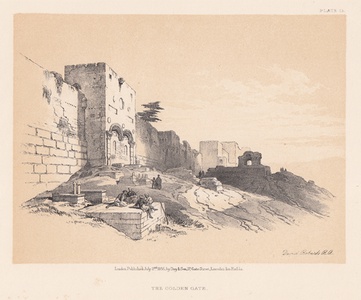| Method | Lithograph with tint stone |
| Artist | after David Roberts |
| Published | London, Published July 2nd. 1855, by Day & Son, 17, Gate Street, Lincoln's Inn Fields |
| Dimensions | Image 135 x 180 mm, Sheet 202 x 285 mm |
| Notes |
Plate 15 from Volume 1 of the small format reprint of Roberts' The Holy Land, Syria, Idumea, Arabia, Egypt & Nubia. A view of the Golden Gate, one of the monumental gates in the walls of the Old City of Jerusalem. The golden gate, though now closed, is the oldest of Jerusalem's gates, likely dating to the building program undertaken by Justinian the Great in the AD 520s. The Byzantine gate stands on the site of various older gates, and biblical tradition holds it to be the gate through which Jesus passed on Palm Sunday, as well as the meeting place of Joachim and Anne, the parents of Mary. In Jewish belief, the Divine Presence will appear through this gate to announce the coming of the Anointed One. The gate was sealed up by the Ottoman Sultan Suleiman the Magnificent in the mid-sixteenth century, though whether this was for defensive or symbolic reasons is still debated. Roberts' view clearly shows the sealed double arch of the gate, with the remnants of a portico before it. A group of Ottoman soldiers sit in a circle on a ruined pediment, while locals stroll on the grassed bank before the walls. David Roberts RA (24th October 1796 – 25th November 1864) was a Scottish painter. He is especially known for a prolific series of detailed prints of Egypt and the Near East produced during the 1840s from sketches made during long tours of the region (1838-1840). This work, and his large oil paintings of similar subjects, made him a prominent Orientalist painter. He was elected as a Royal Academician in 1841. The firm of Day & Haghe was one of the most prominent lithographic companies of the nineteenth-century. They were also amongst the foremost pioneers in the evolution of chromolithography. The firm was established in 1823 by William Day, but did not trade under the moniker of Day & Haghe until the arrival of Louis Haghe in 1831. In 1838, Day & Haghe were appointed as Lithographers to the Queen. However, and perhaps owing to the fact that there was never a formal partnership between the two, Haghe left the firm in the 1850's to devote himself to watercolour painting. The firm continued as Day & Son under the guidance of William Day the younger (1823 - 1906) but, as a result of a scandal involving Lajos Kossuth, was forced into liquidation in 1867. Vincent Brookes bought the company in the same year, and would produce the caricatures for Gibson Bowles' Vanity Fair magazine, as well as the illustrations for Cassells's Poultry Book, amongst other commissions. Condition: Foxing to margins, not affecting image. |
| Framing | unmounted |
| Price | £25.00 |
| Stock ID | 39330 |

